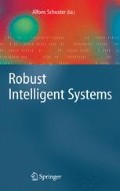Abstract
Natural as well as technical systems owe their robustness to a large extent to feedback structures. To use feedback, it is necessary to define a measurement, an actuator in the system, and a setpoint or reference—the measurement is compared with the reference and an actuator action is derived from the difference between them. This simple but powerful structure is responsible for providing the system with robustness against external influences. For a detailed discussion, the image processing system is chosen. The robustness of an image processing system is considered here to be the ability of an algorithm to achieve the desired output independently of numerous external influences such as illumination conditions, the imaging system, and imaged objects characteristics. Because of a number of problems, such as the absence of feedback from the higher to the lower processing levels, a traditional image processing system is of low robustness. This chapter presents the novel idea of the inclusion of feedback control at different processing levels to overcome the above problems of traditional image processing. The main idea behind this is to change the processing parameters in a closed-loop manner so that the current processing result at a particular processing level is driven to a reference result, providing the subsequent higher processing level with reliable input data. Presenting image processing as a new control application field, the chapter focuses on the specific features of image processing that make closed-loop control in this area different from conventional industrial control. The advantage of feedback for this advanced, prominent, and important application area is demonstrated through two examples.
Access this chapter
Tax calculation will be finalised at checkout
Purchases are for personal use only
Preview
Unable to display preview. Download preview PDF.
References
Abutableb, A. S. (1989). Automatic thresholding of gray-level pictures using two-dimensional entropy. Computer Vision, Graphics and Image Processing, 47(1):22–32.
Bhanu, B. and Lee, S. (1994). Genetic Learning for Adaptive Image Segmentation. Kluwer Academic Publishers, Norwell, MA.
Boyd, S. and Barratt, C. (1991).Linear Controller Design—Limits of Performance. Prentice-Hall, Upper Saddle River, NJ.
Canny, J. (1986). A computational approach to edge detection. IEEE Transactions on Pattern Analysis and Machine Intelligence,8(6):679–698.
Coleman, S. A. (2005). Content-adaptive feature extraction using image variance. Pattern Recognition, 38(12):2426–2436.
Grimble, M. J. (1994). Robust Industrial Control—Optimal Design Approach for Polynomial Systems. Prentice Hall, Englewood Cliffs, NJ.
He, X. C. and Yung, N. H. C. (2004). Curvature scale space corner detector with adaptive threshold and dynamic region of support. In 17th International Conference on Pattern Recognition(ICPR’04), volume 2, pages 791–794, Cambridge, UK.
Hillers, B., Aiteanu, D., and Gräser, A. (2004). Augmented-reality helmet for the manual welding process. In Ong, S. and Nee, A., editors, Virtual and Augmented Reality Applications in Manufacturing, pages 351–370. Springer-Verlag, New York.
Horowitz, I. M. (1993).Quantitative Feedback Design Theory (QFT). QFT Publications, Boulder, Colorado.
Hu, M. K. (1962).Visual pattern recognition by moment invariants. IEEE Transactions on Information Theory, 8:179–187.
Lucas, Y., Domingues, A., Driouchi, D., and Treuillet, S.(2006).Design of experiments for performance evaluation and parameter tuning of a road image processing chain. EURASIP Journal on Applied Signal Processing, 2006: 1–10.
Mirhmedi, M., Palmer, P. L., and Kittler, J. (1997). Robust line segment extraction using genetic algorithms. In 6th IEE International Conference on Image Processing and its Applications, pages 141–145, Dublin, Ireland. IEE Publications.
Mokhtarian, F. and Suomela, R. (1998). Robust image corner detection through curvature scale space. IEEE Transactions on Pattern Analysis and Machine Intelligence,20(12):1376–1381.
Peng, J. and Bhanu, B. (1998).Closed-loop object recognition using reinforcement learning. IEEE Transactions on Pattern Analysis and Machine Intelligence, 20(2):139–154.
Ristić, D. (2007). Feedback Structures in Image Processing, PhD Thesis. Shaker Verlag.
Ristić, D. and Gräser, A. (2006). Performance measure as feedback variable in image processing. EURASIP Journal on Applied Signal Processing, 2006:1–12.
Ristić, D., Volosyak, I., and Gräser, A. (2005). Feedback control in image processing. ATP International—Automation Technology in Practice, 1:61–75.
Sifakis, E. and Tziritas, G. (2003). Robust object boundary determination using locally adaptive level setalgorithm. In International Conference on Image Processing, volume 1, pages 141–144, Barcelona.
Volosyak, I., Ivlev, O., and Gräser, A.(2005). Rehabilitation robot FRIEND II—the general concept and current implementation. In 9th International Conference on Rehabilitation Robotics(ICORR’05), pages 540–544, Chicago, Illinois.
Vuppala, S. K., Grigorescu, S., Ristić, D., and Gräser, A. (2007). Robust color object recognition for a service robotic task in the system FRIEND II. In 10th International Conference on Rehabilitation Robotics (ICORR’07), pages 704–713, Netherlands.
Wirth, M., Fraschini, M., Masek, M., and Bruynooghe, M. (2006). Performance evaluation in image processing. EURASIP Journal on Applied Signal Processing, 2006:1–15.
Zhou, J. and Shi, J. (2001). A robust algorithm for feature point matching. Computer and Graphics, 26:429–436.
Author information
Authors and Affiliations
Corresponding author
Editor information
Editors and Affiliations
Rights and permissions
Copyright information
© 2008 Springer-Verlag London Limited
About this chapter
Cite this chapter
Gräser, A., Ristić, D. (2008). Feedback Structures as a Key Requirement for Robustness: Case Studies in Image Processing. In: Schuster, A. (eds) Robust Intelligent Systems. Springer, London. https://doi.org/10.1007/978-1-84800-261-6_9
Download citation
DOI: https://doi.org/10.1007/978-1-84800-261-6_9
Publisher Name: Springer, London
Print ISBN: 978-1-84800-260-9
Online ISBN: 978-1-84800-261-6
eBook Packages: Computer ScienceComputer Science (R0)

